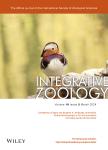Distribution and space use of seed-dispersing rodents in central Pyrenees:implications for genetic diversity,conservation and plant recruitment
作者机构:CREAFCerdanyola del VallésCataloniaSpain Department of Didactics of Experimental SciencesFaculty of EducationUniversity Complutense of MadridMadridSpain Forest Research GroupINDEHESAUniversity of ExtremaduraPlasenciaSpain DITEG Research GroupUniversity of Castilla-La ManchaToledoSpain Research group of Genetic and Cultural BiodiversityResearch centre for Cinegetic Resources(CSIC-UCLM-JCCM)Ciudad RealSpain
出 版 物:《Integrative Zoology》 (整合动物学(英文版))
年 卷 期:2018年第13卷第3期
页 面:307-318页
核心收录:
学科分类:0710[理学-生物学] 071001[理学-植物学] 07[理学]
基 金:This work was supported by the projects IMPACTBOAR(394/2011)and PLAGANADO AGL2014-54739-9 R.B.was funded by a contract of the Atracción de Talento Investigador Programme(Gobierno de Extremadura TA13032)
主 题:DNA analysis Pyrenees rodents seed dispersal vegetation structure
摘 要:The function and conservation of many forest ecosystems depend on the distribution and diversity of the community of rodents that consume and disperse *** habitat preferences and interactions are especially relevant in alpine systems where such granivorous rodents reach the southernmost limit of their distribution and are especially sensitive to global *** analyzed the community of granivorous rodents in the Pyrenees,one of the southernmost mountain ranges of *** species were identified by DNA with particular attention to the Apodemus species,which are prominent seed-dispersing rodents in *** confirmed for the first time the presence of the yellow-necked mouse,Apodemus flavicollis,in central Pyrenees,a typical Eurosiberian species that reaches its southernmost distribution limit in this *** also found the wood mouse,Apodemus sylvaticus,a related species more tolerant to Mediterranean *** rodents were spatially segregated by *** was rare at high altitudes,which might cause the genetic differentiation between populations of the different valleys reported *** also found other seed consumers like dormice,Elyomis quercinus,and voles,Myodes glareolus,with marked habitat *** suggest that population isolation among valleys may increase the genetic diversity of rodents,like *** also highlight the potential threat that global warming may represent for species linked to high-altitude refuges at the southern edge of its distribution,like Apodemus ***,we discuss how this threat may have a dimension in the conservation of alpine forests dispersed by these rodent populations.



